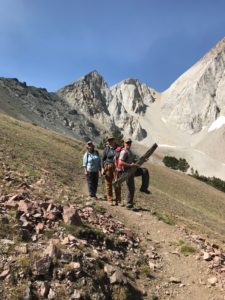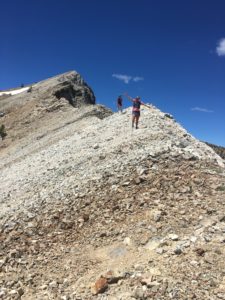As snow begins to dust the mountaintops, the 2018 wilderness steward season in Central Idaho has come to a close. The program, now in its third year, made large gains. The number of volunteer stewards has doubled since the first year of the program in 2016. With more eyes and ears on the ground, the stewards encountered many more visitors on the trail than ever before, packed out more trash and cleaned more fire rings. In fact, they did more of everything. Our most active steward went on 27 patrols over the course of the steward season – from June to mid-October.
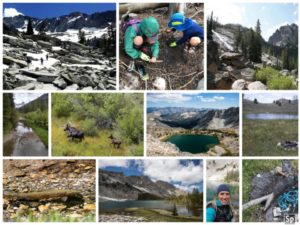
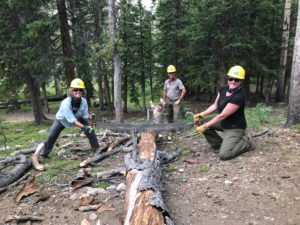
By the Numbers
Here’s what our stewards achieved and encountered this season:
- Steward patrols: 166
- Hours patrolled: 1,400
- Motorcycle riders: 37
- Illegal motorcycle riders: 2
- Day hikers: 1,350
- Number of parties: 717
- Backpackers: 925
- Day riders: 68
- Abandoned campfires extinguished: 1
- Day riders (Stock): 45
- Total humans encountered: 2,464
- Horse/mule packers: 40
- Horse/mule packers (stock): 65
- Pounds of litter packed out: 613.5
- Goat packers: 3
- Goats: 8
- Llama packers: 8
- Llamas: 2
- Fire rings destroyed (and naturalized): 102
- Fire rings cleaned: 87
- Commercial aircraft encounters: 100
- Local aircraft encounters: 77
- Abandoned campfires extinguished: 1
- Human waste issues: 33
- Legal mountain bikers: 33
- Illegal mountain bikers: 0
- Dogs off leash: 292
- Dogs on leash: 114
Thanks to the increased number of stewards patrolling, the number of visitors encountered within the wilderness increased by over 60% from the first year of the steward program in 2016. The number of illegal fire rings and human waste issues also increased dramatically – 40% and 60% respectively. Part of the reason we’re seeing more human impact is that the steward program is expanding, and more stewards means more observations. However, per hour patrolled, stewards are encountering more violations. In 2017, for every hour patrolled, a steward only came across an illegal fire ring on 3.5% of their patrols while in 2018 that number jumped up to 7%. So the season brought more stewards, more observations, but also more violations.
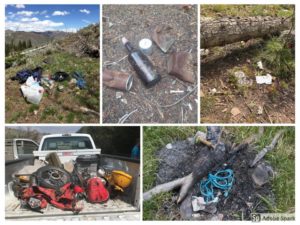
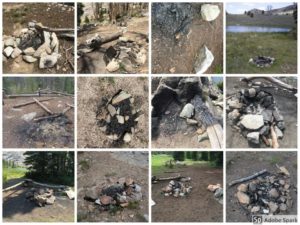
Why Are Violations Increasing?
When I first looked at the numbers this season, I assumed that the increased violations were due to an increase in the number of people on the trails. However, the number of people stewards have encountered has remained surprisingly static per steward patrol over time. If we’re seeing a consistent number of people out on the trails, why are violations increasing?
I believe this indicates a lack of visitor education. The informational signs at trailheads and even the wilderness permits required in the Sawtooths don’t seem to be enough for a visitor to understand the rules that are in place to protect these critical environments. And even less so, to comprehend the devastating impact that breaking the rules can have. How do we educate more people on why it’s so important to be respectful stewards of the wilderness environment?
One way is to explain why we ourselves make it a priority to give back. Here are some of the reasons our volunteers this year chose to be part of the program:
- "Give back to the wilderness."
- "Because I enjoy the wilderness areas surrounding our valley and want to do my part in keeping them special."
- "For love of wilderness."
- "A chance to participate in keeping the Idaho wilderness as it should be."
- "I cherish our great outdoors and enjoy being part of preserving it."
The Conservation Conversations
Connecting with other people face-to-face in the wilderness and talking about why these places matter to us and why each of us is compelled to do a little (or a lot) extra to protect them every time we’re out on the trails – these conversations can have a meaningful impact on how other visitors treat our wild places.
This year our stewards had the potential to influence 2,464 people and teach them how to be better stewards of their environment. These conversations are not easy – it is often very intimidating to approach a stranger to explain the policy they’re violating and educate them on better practices. Though difficult, these interactions are critical. Having an honest, non-confrontational and informative conversation may be the only way to teach other people how to take care of the wilderness. It very well might be the only way these visitors learn that they’re having an adverse impact at all.
Not all visitor interactions involve an educational conversation. They can be and often are positive, too. A few positive comments that our stewards reported hearing from visitors this past season:
- “The trail was in great shape and very clean!!” “Your Wilderness Stewards program is awesome and much appreciated!!” – a Portland, OR, group
- They have seen “nothing as spectacular as this.” – a couple from Utah who enjoy their home trails
- “This is way better than Glacier National Park!”
These positive interactions are a reminder that although some visitors have a lot to learn about protecting the wilderness, the majority are out there enjoying these incredible places and doing what they can to minimize their impact.
This past spring, the White Clouds Wilderness was renamed the Cecil D. Andrus-White Clouds Wilderness. Andrus sat down with Rick Johnson, executive director of the Idaho Conservation League, for a conversation in 2014 in which he declared, "Who was the philosopher who said, talking about the land, ,they just ain’t making more of it anymore?’ You’ve got to protect these areas."
Our best shot at continuing to protect these places may be talking to and educating other visitors about what it is that makes them so important to each of us personally.


